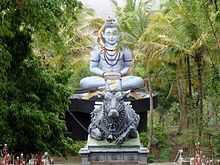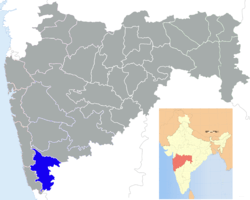Siddhagiri Gramjivan Museum (Kaneri Math)
Siddhagiri Gramjivan Wax Museum (Kaneri Math) at Kaneri, near Kolhapur, Maharashtra, is a wax museum. The full name is Siddhagiri Gramjivan (Village life) Museum. It is situated at Shri Kshetra Siddhagiri Math.
Museum
Though Kaneri Math is well-known, the museum is less-known. A unique project, perhaps the only project in India situated at Shri Kshetra Siddhagiri Math, Kaneri, district Kolhapur, Maharashtra. The place is near Kolhapur city on Pune Banglore Highway. Shri Kshetra Siddhagiri Math has a history of more than 1300 years, and is a holy place of worship of Lord Mahadeva. The surrounding around the museum is very calm and quiet, a hilly place with a good collection of Flora and Fauna.
The project is a dream village of Mahatma Gandhi, visually and symbolically created through the vision and efforts of present 49th Mathadhipati H.H. Adrushya Kadsiddheshwar Swamiji.
The main objective of the Project is to refresh the history of self-sufficient village life before the invasion of Mughals in Maharashtra. There were 12 BALUTEDARS (12 main profession based casts i.e. Professions performed by generation by family members) and 18 ALUTEDARS, who provided equipments to all villagers useful in their day-to-day necessities of domestic as well as Agricultural life.
These Balutedars, Alutedars and others had a special characteristics with which they served society. The description of all 18 Alutedars, 12 balutedars and other people and there duties are vividly depicted in the museum.
The first phase of the museum spans over 7 Acres of area with almost 80 main scenes and around 300 statues. Several subtle village lifestyles are taken into consideration. There is a unique combination of expression, accuracy and liveliness in the whole village. Each sculpture has a multi dimensional effect and lifestyle theme which Swamiji very keenly arranged each and every scene to make a proper visual story. In the total cluster the village demonstrate a self-sufficient machinery within village. Barter economy, Interpersonal healthy happy relationship among villagers is reflected. The Museum projects the entire village as a single family, and as single family members in a joint family. No adulteration, no cut thought practice, no mad Rat Race, No pollution, but Caring, and delightful atmosphere, no bitter feeling, but fertile land, clean water, clean air, quality food, maximum use of natural resources, cattle field, livestock, job satisfaction. All these things are reflecting the beauty, Joy, satisfaction of human race and oneness with nature. It advises us to get back to nature, without disturbing the equilibrium of nature and many other things which are beyond our imagination.
Museum theme
This museum showcases different aspects of Gramjivan (village life). ‘Gram’ means ‘village’ and ‘jivan’ means ‘life’ in Marathi language. This initiative was dream project of Mahatma Gandhi, visually and symbolically created through the vision and efforts of Siddhagiri Gurukul Foundation Trust. The history of self-sufficient village life before invasion of Mughals in Maharshtra is depicted here in the form of cement sculptures. Each sculpture is lifelike and has a multi dimensional effect and lifestyle theme. There were 12 ALUTEDARS (12 main profession-based castes i.e. Professions performed from generation to generations by families) and 18 BALUTEDARS, who provided equipments to all villagers to fulfill their day-to-day necessities (domestic as well as professional).
The museum is spread over 7 acres (28,000 m2) area and has almost 80 scenes which showcase more than 300 statues. The surrounding countryside is beautiful and is surrounded with lush greenery. Every aspect of village life has been depicted in this museum. It is a perfect blend of fact, powerful imagination and enormous hard work in getting the lifelike expressions of the whole village.
Few of the scenes
- Village priest’s abode: First scene is the house of a highly educated village priest. He performs his duties, rites and rituals like weddings, thread ceremonies and is tasked to find auspicious days and time for any major activity e.g. house building and house warming activities, digging of new wells, start of sowing seeds, pierching nose or ears etc. He earns his livelihood from ‘Dakshina’ (donations) he receives. He consults the ‘Panchaang’ (almanac) for finding auspicious dates.
- Goldsmith at work
- Nailing the bullock with iron shoe
- Barber shop
- Village well: Villagers fetching water from the public well.
- Nursing an elder family member
- Grocer’s shop: Woman visiting the grocery shop with her son. The shop-keeper is weighing items in old weighing machine. Items like jaggery, sugar, chillies, salt, wheat, rice are stocked. The son is asking his mother to buy kites for him.
- Farmer’s ‘Wada’ (house)
- House of ‘Vaidya’
- Grandma stitching ‘Godhadi’ (quilt)
- Farmers ploughing his farm using bullocks
- Shepherd boy with his herd of sheep
- Villagers performing Bhajan and Kirtan (singing Hindu devotional songs)
Kaneri Math
| Inchegeri Sampradaya | |||||||||||||
|---|---|---|---|---|---|---|---|---|---|---|---|---|---|
| Rishi Dattatreya, mythological deity-founder.[lower-alpha 1][lower-alpha 2] | |||||||||||||
| Navnath, the nine founders of the Nath Sampradaya,[lower-alpha 3][lower-alpha 4] | |||||||||||||
| Gahininath,[lower-alpha 5] the 5th Navnath[lower-alpha 6] | Revananath, the 7th[lower-alpha 7] or 8th[lower-alpha 8] Navnath, also known as Kada Siddha[lower-alpha 9] | Siddhagiri Math[lower-alpha 10][lower-alpha 11] c.q. Kaneri Math (est. 7th[lower-alpha 12] or 14th century[lower-alpha 13]; Lingayat Parampara[lower-alpha 14] c.q. Kaadasiddheshwar Parampara[lower-alpha 15] | |||||||||||
| Nivruttinath, Dnyaneshwar's brother[lower-alpha 16] | |||||||||||||
| Dnyaneshwar[lower-alpha 17] (1275–1296) also known as Sant Jñāneshwar or Jñanadeva[lower-alpha 18] and as Kadasiddha[lower-alpha 19] or Kad-Siddheshwar Maharaj[lower-alpha 20] | |||||||||||||
|
Different accounts: | |||||||||||||
| 1 | Nimbargi Maharaj (1789-1875) also known as Guru Lingam-Jangam Maharaj [lower-alpha 28][lower-alpha 29][lower-alpha 30] |
23rd Shri Samarth Muppin Kaadsiddheswar Maharaj | |||||||||||
| 2 | Shri Bhausaheb Maharaj Umdikar[lower-alpha 31][lower-alpha 32] (1843 Umdi - 1914 Inchgiri[lower-alpha 33]) | 24th Shri Samarth Muppin Kaadsiddheswar Maharaj | |||||||||||
| 3 | H.H. Shri Amburao Maharaj of Jigjivani (1857 Jigajevani - 1933 Inchgiri)[lower-alpha 34][lower-alpha 35] |
Shivalingavva Akka (1867-1930)[lower-alpha 36] | Girimalleshwar Maharaj[lower-alpha 37][lower-alpha 38] | Sri Siddharameshwar Maharaj (1875-1936)[lower-alpha 39][lower-alpha 40] | 25th Shri Samarth Muppin Kaadsiddheswar Maharaj | ||||||||
| 4 | H.H. Shri Gurudev Ranade of Nimbal (1886-1957)[lower-alpha 41][lower-alpha 42][lower-alpha 43][lower-alpha 44][lower-alpha 45] | Balkrishna Maharaj[lower-alpha 46] | Shri Aujekar Laxman Maharaj[lower-alpha 47] | Madhavananda Prabhuji (d. 25th May, 1980)[lower-alpha 48] |
Sri Nisargadatta Maharaj (1897–1981)[lower-alpha 49] |
|
26th Shri Muppin Kaadsiddheshwar Maharaj (1905-2001) Student of Sri Siddharameshwar Maharaj[lower-alpha 55] | ||||||
| 5 | H.H Shri Gurudev Chandra Bhanu Pathak[lower-alpha 56] | Bhausaheb Maharaj (Nandeshwar)[lower-alpha 57] | Shri Nagnath Alli Maharaj[lower-alpha 58] |
|
27th head: H.H. Adrushya Kadsiddheshwar Swamiji[lower-alpha 76] | H. H. Jagadguru Ramanandacharya Shree Swami Narendracharyaji Maharaj[lower-alpha 77] | |||||||
| |||||||||||||

Kaneri Math is holy place with a Shiva temple.[1] It is believed that a Shivling was installed by a Lingayat Priest on a beautiful hill in the 14th century. The temple is beautiful and peaceful with a huge Nandi. About 500 years ago, a Lingayat Priest Shree Kadsiddheshwar Maharaj developed and renovated it and hence the place is now known by his name. A 125 feet (38 m) deep well and a 42 feet (13 m) huge Shiva idol is worth seeing.
Location
To reach Siddhagiri Museum:
- Take the Kolhapur-Bangalore NH 4
- Travel approx 10–12 km.
- Take right from Gokul Shirgaon Junction to go to Kaneri village.
- Drive approx 4–5 km to reach Siddhagiri Museum.
See also
References
External links
| |||||||||||||||||||||||||||||||||||||||||||||
